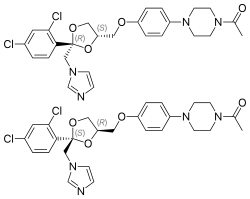 (2R,4S)-(+)-ketoconazole (top) (2S,4R)-(−)-ketoconazole (bottom) | |
| Clinical data | |
|---|---|
| Pronunciation | /ˌkiːtoʊˈkoʊnəˌzoʊl, -zɒl/[1][2] |
| Trade names | Nizoral, others |
| Other names | R-41400; KW-1414 |
| AHFS/Drugs.com | Systemic: Monograph Topical: Monograph |
| MedlinePlus | a682816 |
| License data |
|
| Pregnancy category |
|
| Routes of administration | By mouth (tablets), topical (cream, shampoo, solution) |
| Legal status | |
| Legal status | |
| Pharmacokinetic data | |
| Bioavailability | By mouth: 37–97%[5] |
| Protein binding | 84 to 99% |
| Metabolism | Extensive liver (predominantly oxidation, O-dealkylation) |
| Metabolites | N-deacetyl ketoconazole |
| Elimination half-life | Biphasic |
| Excretion | Biliary (major) and kidney[6] |
| Identifiers | |
| |
| Chemical and physical data | |
| Formula | C26H28Cl2N4O4 |
| Molar mass | 531.43 g·mol−1 |
| 3D model (JSmol) | |
| Chirality | Racemic mixture[6][7] |
| |
| |
| | |
Ketoconazole, sold under the brand name Nizoral among others, is an antifungal medication used to treat a number of fungal infections.[10] Applied to the skin it is used for fungal skin infections such as tinea, cutaneous candidiasis, pityriasis versicolor, dandruff, and seborrheic dermatitis.[11] Taken by mouth it is a less preferred option and only recommended for severe infections when other agents cannot be used.[10] Other uses include in the treatment of excessive hair growth and Cushing's syndrome.[10]
Common side effects when applied to the skin include redness, itch, and stinging.[12] Common side effects when taken by mouth include nausea, headache, and liver problems.[10] Liver problems may result in death or the need for a liver transplantation.[10][13] Other severe side effect when taken by mouth include QT prolongation, adrenocortical insufficiency, and anaphylaxis.[10][13] It is an imidazole and works by affecting the production of ergosterol required for the fungal cell membrane thereby slowing growth.[10]
Ketoconazole was patented in 1977 and came into medical use in 1981.[14] It is available as a generic medication and formulations that are applied to the skin are over the counter in the United Kingdom.[11] A 30-gram tube in the United Kingdom costs the NHS less than £5 as of 2019.[11] In the United States, where the topical cream is available only by prescription, the wholesale cost of this amount is about US$6.30.[15] In 2017, it was the 219th most commonly prescribed medication in the United States, with more than two million prescriptions.[16][17] The formulation that is taken by mouth was withdrawn in the European Union and in Australia in 2013[18][19] and in China in 2015.[20] In addition, its use was restricted in the United States and Canada in 2013.[19]
References edit
- ^ "Ketoconazole". Merriam-Webster.com Dictionary.
- ^ "Ketoconazole". Dictionary.com Unabridged (Online). n.d.
- ^ "Ketoconazole HRA 200mg Tablets - Summary of Product Characteristics (SmPC)". (emc). 18 September 2017. Retrieved 1 April 2020.
- ^ "Ketoconazole 2% w/w Shampoo - Summary of Product Characteristics (SmPC)". (emc). 5 October 2015. Retrieved 1 April 2020.
- ^ Millikan, Larry E. (19 April 2016). Drug Therapy in Dermatology. CRC Press. pp. 82–. ISBN 978-0-203-90831-0.
- ^ a b "Assessment report: Ketoconazole HRA" (PDF). www.ema.europa.eu. European Medicines Agency. Committee for Medicinal Products for Human Use. Archived (PDF) from the original on 27 August 2016. Retrieved 26 August 2016.
- ^ Arakaki R, Welles B (February 2010). "Ketoconazole enantiomer for the treatment of diabetes mellitus". Expert Opinion on Investigational Drugs. 19 (2): 185–94. doi:10.1517/13543780903381411. PMID 20047506.
- ^ "WHOCC - ATC/DDD Index". www.whocc.no. Retrieved 9 September 2020.
- ^ "WHOCC - ATC/DDD Index". www.whocc.no. Retrieved 9 September 2020.
- ^ a b c d e f g "Ketoconazole Monograph for Professionals". Drugs.com. American Society of Health-System Pharmacists. Retrieved 23 March 2019.
- ^ a b c British national formulary : BNF 76 (76 ed.). Pharmaceutical Press. 2018. p. 1198. ISBN 9780857113382.
- ^ Gupta, Aditya K.; Mays, Rachel R.; Folley, Kelly A. (2019). "42. Topical antifungal agents". In Wolverton, Stephen E.; Wu, Jashin J. (eds.). Comprehensive Dermatologic Drug Therapy (4th ed.). Elsevier. p. 484. ISBN 978-0-323-61211-1.
- ^ a b "FDA limits usage of Nizoral (ketoconazole) oral tablets due to potentially fatal liver injury and risk of drug interactions and adrenal gland problems". FDA Drug Safety Communication. U.S. Food and Drug Administration. 26 July 2013. Archived from the original on 2 December 2013. Retrieved 23 November 2013.
- ^ Fischer, Jnos; Ganellin, C. Robin (2006). Analogue-based Drug Discovery. John Wiley & Sons. p. 503. ISBN 9783527607495.
- ^ "NADAC as of 2019-02-27". Centers for Medicare and Medicaid Services. Retrieved 3 March 2019.
- ^ "The Top 300 of 2020". ClinCalc. Retrieved 11 April 2020.
- ^ "Ketoconazole - Drug Usage Statistics". ClinCalc. Retrieved 11 April 2020.
- ^ "Oral ketoconazole (Nizoral) 200 mg tablets". Therapeutic Goods Administration (TGA). 10 October 2013. Retrieved 23 March 2019.
- ^ a b Gupta AK, Lyons DC (2015). "The Rise and Fall of Oral Ketoconazole". Journal of Cutaneous Medicine and Surgery. 19 (4): 352–7. doi:10.1177/1203475415574970. PMID 25775613.
- ^ "国家食品药品监督管理总局关于停止生产销售使用酮康唑口服制剂的公告(2015年第85号)" (in Chinese). China Food and Drug Administration. 25 June 2015. Archived from the original on 2 July 2015. Retrieved 2 July 2015.